Sunday, May 31, 2009

Sofia Design Week was held in Sofia Bulgaria from June 5th-12th 2009.
Dima Stefanova, designer of the website of Gerrit Rietveld Academie and Sandberg/Design Institute and Henk Groenendijk, moderator of Designblog form together Icecreamdesign. As advisers they are involved from the beginning in this fist ever Bulgarian Design Week. As speakers and organizers of the “Bird’s Eye View” workshop they participate in the program.
“One Magazine” interviewed them for their latest issue
Next Identity Forum took place during a 7 day long event with lectures, workshops, exhibitions and presentations that gathers representatives of the worlds design avant-garde in product, communication, graphic and interactive design.
In search of its next identity, Sofia welcomed 17 of the most indicative in their field. Putting Sofia on the global design map for the first time. Ji Lee, Niessen en de Vries ( the succesful traveling instalation TM-City was on display again), Peik Suyling YD+I, Frank Tjepkema “Tjep”, Marti Guixe, Erik Kessels from KesselsKramer, Lust en Ruedi Bauer were attending among many others.
By Henk Groenendijk
/ Categories: graphic design, interaction-design, interieur design, product design Tags: Frank Tjepkema, Icecreamdesign, Ji Lee, KesselsKramer, less-or-more, lust, Marti Guixe, Richard Niessen, TM-City, workshop, YD+I
No Comments
Thursday, May 28, 2009
In my first post about two of the most important and influential dutch graphic designers, Wim Crouwel and Anthon Beeke (pdf), i tried to compare them by their different approach. Especially the way Beeke designed, really intrigued me.
It was provocating and controversial which made him one of the leading conceptual engaged designers.
On the other side, Wim Crouwel is known as a more functional designer, which means less conceptual.
But is it really that easy to divide and are all this categorizations correctly made?
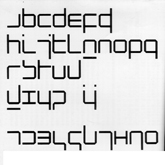

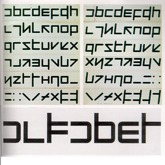
Especially in the case of Wim Crouwel i doubt it. His design of the new alphabet was based on the begin of computer technology, in a time were blogs, facebook and internet in general didn’t exist. Coming up with a font type based on this new technology combines in a perfect way a clear, functional and computer like approach. Computer like is also the keyword for, in my opinion, a highly conceptual design.
With the awareness that this technology will change they way we communicate, document, the way we are. His style is timeless (even if it also relates to the early 70s) and applicable still nowadays.
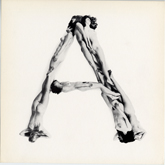
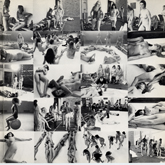

Beeke’s Human alphabet, using the aesthetics (look at the swedish film makers Ingmar Bergman and Vilgot Sjöman) and social and political topics like sexuality, seems more related to that specific time.
So Aesthetics is next to conceptualism and functionalism a really important aspect, what makes Crouwel’s design less depend on a certain time period.
Never the less, Anthon Beeke’s radical and shocking way, even if it is not so applicable in our times anymore, was responsible for breaking through the conservatism of (Graphic design) and is so a mirror of other important political and social openings in this time period, and even if his aesthetics are not so up to date, his conceptual engagement is.
link: The Human Alphabet as a visual brand
link: Anton Beeke exhibit at Centre for Visual Arts Zeeland
Monday, May 25, 2009

While visiting Hong Kong last week, I noticed the huge difference in standard between their graphic design and our graphic design. If you only look to their graphic design you will think that they are all insane lunatics. They give faces to everything, use the color pink to sell men products and combine business posters with pigs. I used this as my starting point for my research. What is the difference in standard telling us about the culture of Hong Kong? You can all read it in my weblog.
Wednesday, May 13, 2009
Building & Identity became subject of plans to move Amsterdam’s Art & Design Academy (The Gerrit Rietveld Academie) to an other location.
Academy and building named after the same conceptual visionair Gerrit Rietveld cause an interesting concourse, in which the identity of our renown academy building is suddenly confronted with an evenly famous and internationally renown educational identity. (
link to student research)
As part of a teachers and students protest against the “ad hoc” plans, celebrating the 42nd birtday of the Rietveld building, a T-shirt was designed after the famous “Beatles” T-shirt by Experimental Jetset, to emphasize this realation between content and identity. Rietveld is building and students and teachers as the Beatles still are John&Paul&Ringo&George. link


Rietveld for Rietveld
www.rietveldforrietveld.org
The goal of this website is to open the discussion on the preservation of the historical Rietveld building for the Gerrit Rietveld Academy, Amsterdam.
Read more about this and all ongoing facts and publicity ¿GRA becomes GAK?
Tuesday, May 12, 2009
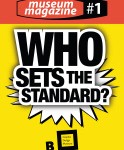

Today, virtually every designer works with the same creative software, which to a large degree determines the aesthetics of design. Millions of websites make use of just a handful of basic layouts. Browsers, search engines and content management systems have the same implications for the design of the web as the offset press and the A4 format once had for printed material.
Technology has always had a great influence on design. The modernistic visual language became successful because it could be easily reproduced, not because of its idealistic principles.
The business community, brands, and media fight for the attention of the critical consumer. Design speaks a universal language and extends beyond geographic borders. Jan Tschichold can be satisfied.
The question is who was really responsible for this: celebrated superstar designers or anonymous engineers driven by ingenious marketing concepts? Successful design has become the equal of generic design. Recognition is the most successful product of our time.
Sunday, May 10, 2009
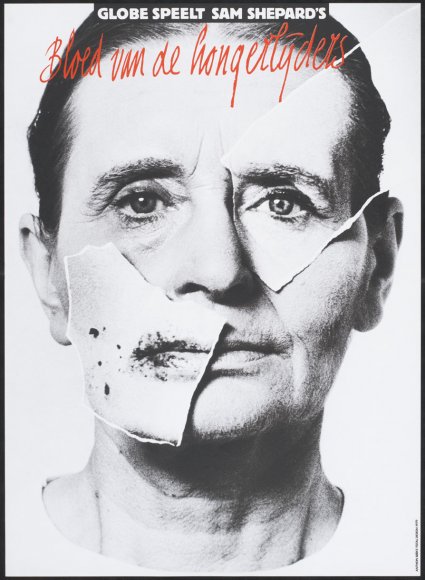
Anton Beeke’s poster for the theatrical play “Bloed van de Hongerlijders” (Blood of the starving ones) is a complex, yet at the same time striking “in your face” like work. Attempting to create an image that contains a deeper psychological meaning, Beeke executed the work while making use of different techniques. First of all there is the photograph, depicting a man in probably his early fifties. Furthermore present are yet two other photos. Where the first photo seems ordinary in the way it is presented (one recognizes a portrait that is, consistent with the convention, merely showing the face of the person depicted and partially the neck), the two other photos are peculiar. They are both cut-outs from other photos, pasted on the first picture. All the more strange it seems that also these two photos differ from each other. Although they both fit on the man’s face (from which they seem to be copies), they physically don’t match. Whereas one might assume that the right picture is a genuine copy of the original, the left photo shows spots and irregularities that could be associated with sickness. What could be going on here? Are we dealing with a Janus-like figure, perhaps a schizophrenic madman? Or was Beeke only pointing out an ambiguity with which we would be confronted with while attending the play? Presumably the answer behind these questions lies hidden within the layers of this work. Until we see it, we can only speculate. And exactly this curiosity is what a poster should revoke!
WHEN THE FACE BECOMES A MASK
What has happened to this man? Are we dealing with a Janus-like figure, perhaps a schizophrenic madman? And what could the artist’s intention be? Might Beeke have been pointing out an ambiguity with which we would be confronted with while attending the play? Presumably the answer behind these questions lies hidden within the layers of this work….read more about his poster in the linked pdf
Friday, May 8, 2009
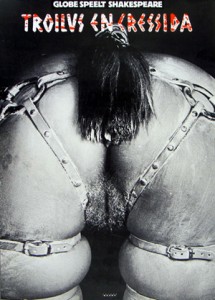
My father once said to me that a good piece of art should slap you in the face.
Even though I disagree with him sometimes, I liked that a lot and I like to be slapped in the face.. It is not often that you are struck by something in such a manner that it stay’s in the mind and overgrows everything that mattered less.
Of course the blow can come from different angles (beauty, shock, alienation, directness, physical impact) but looking at this poster from Anthon Beeke I immediately experienced the ‘slap in the face’ again.
A lot of my fellow students thought the thing horrid and filthy and I can totally understand that. This image illustrates some of the associations we make between for instance : women, horses and sexuality. I think that feeling of repulsion comes from the hidden knowledge we have about our own beastly behavior and the gender specific features that come with that. Moreover it touches upon the similarities between humans and animals.
A while ago one of my friends said she had seen two horses mate and that it had horrified her, why?, because the aggressiveness with which the stallion had moved reminded her vaguely of her ex-husband.
We can find the truth within language; do we not refer to certain men with the word ‘stud’? And do we not aim for a specific type of woman using the term broodmare?
Some displays in this exhibition made me curious, some designs were funny or even beautiful, I marveled over the poster designs from Jan Toorop and Jan Tschichold, However…; appreciating something is not the same as being hit by something. Anthon Beeke really struck, with this beautiful, raw and direct image.
This poster was made for a tragedy written by Shakespeare, I will never forget that play now, and I every time I saddle my horse for a ride I will think about Troilus and Cressida.
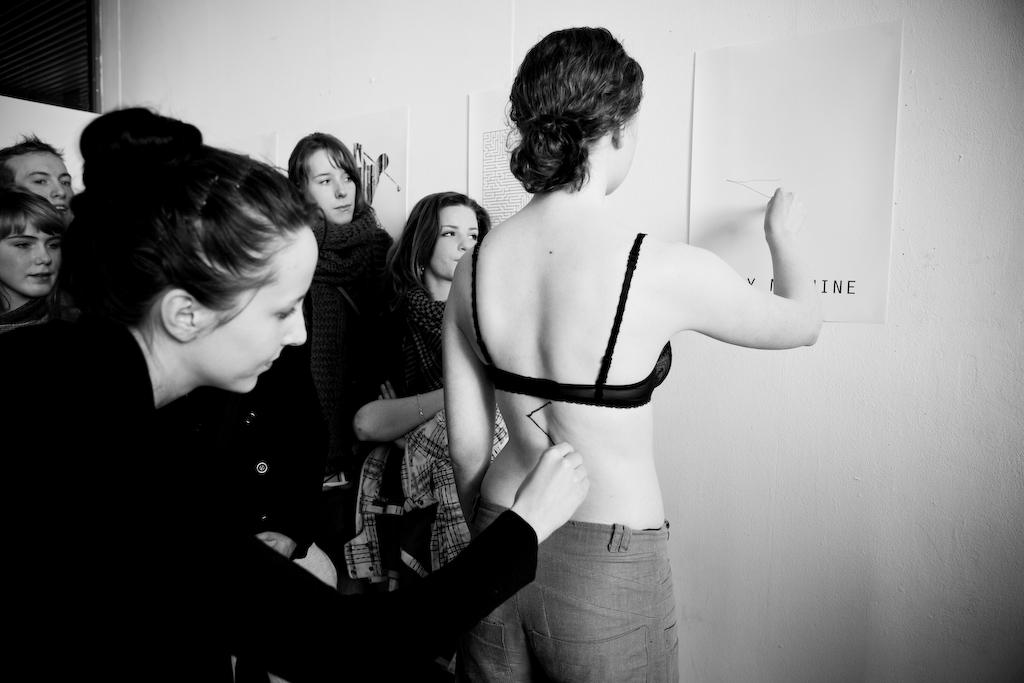
LUST DOES NOT MAKE ME HOT
Why is it that some works of art stay with you, and others do not?
When you go through an exhibition, an art fair or an Art book there are only very few things you remember, that stay with you, the rest ….. will be continued in this linked pdf
Wednesday, May 6, 2009


Jan Toorop was a Dutch painter and illustrator who worked between 1880 and 1928 In 1894 the Nedelandsche Slaolie Fabrieken asked him to do an advertisement poster. He came up with this: A litho in the Art Nouveau style. Very popular at the time. Made famous by Alphonse Mucha and his posters for Sarah Bernard.
If you analyze the work you can clearly see the artists hand and the customers’ wishes. This image however is published in almost every Jugendstil or Art Nouveau publication. And even became the Dutch nickname for Art Nouveau. The name’’ Slaoliestijl’’ was not only used for Graphic Design, but was also adapted in Product design.
And this is the question that troubles me most; How did a respected Symbolist painter cope with the success of his graphic work? Not acknowledged as an art form, but as a trade, at the time.
Another question that troubles me is; would it be possible nowadays, for an autonomous artist, to do advertisements without doing damage to his own work or reputation?
If you look at museums of modern art nowadays, you can see that most of them took design into their collections. This means art and design are moving towards each other. And interesting development followed with lots of discussion.
RESEARCH QUESTION: do commissions damage a autonomous artist reputation?
Wednesday, May 6, 2009
We went with school to the Graphic Design museum in Breda to the exposition ‘Who sets the standard?’. There were lots of nice things to see, and i found a book as well that was made by the Dutch designer Irma Boom that made me curious. It was laying on a table in a glass box, opened on one of the pages. Next to it you could find information on a computer touch screen about the maker and the book. This was also a very nice design, cause it worked very well and interesting to look into, very professional.
I want to know more about book design in general and i understand that this peticular book is a very remarkeble example. The ultimate book. So i’m going to investigate more about the maker Irma Boom and her designs.
 The book is made for the SHV Holdings, from origin a cole trading company, but now a days it trades in food and other fuels and chemicals.
The book is made for the SHV Holdings, from origin a cole trading company, but now a days it trades in food and other fuels and chemicals.
The design and the content are about the history of thi company itself but also about the family that owned it for all these years and reflects upon generations of living and working. There are just a few of them made, as the book was meant as a jubilee gift to high executives only. There is even a limited amount made specially in Chinees as it turned out after printing many of them were in china. It has never been forsales so it is quite rare to see one. I got the opportunity to see and look into the SHV Think Book myself at a private home of a lucky owner, and I found out how amazing a book design can be.
It was a great experience to go trough this book. It is a monument for the SHV, a travel trough the time, and it is far from a dry documentation. Irma Boom got into the content of her subject and you feel this. She tells the stories of the company in a playful and inventive way, it is filled with ingenious visual and linguistic jokes, poems, repetitions and personal stories, but because Irma Boom really knows what she is doing and directs it tightly, it never gets to much or chaotic.
THE SHV THINK BOOK
Fentener van Vlissingen is a philanthropist that supports several humanistic projects. When he searched for someone to design a jubilee book, he asked Irma Boom to do it. It was a work of five years and it is a good representation of all the work and effort and love that has been putted in the company itself. Read more as the story unfolds in this linked pdf……….
Wednesday, May 6, 2009
Standing in front of the works of Jan Tschichold, I felt suddenly something very familiar arising within me. An old memory dream-like of the time I studied graphics in the Academy of Fine Arts in Warsaw. As for those days, it didn’t really feel right, however now suddenly it all made sense. It occurred to me, like a missing piece of a puzzle being found, a key to connect those days to „today“. At once I could see all the rules of typography an graphic design emerge within the posters. Like hidden signs, which were not an obstacle. Rather a guideline, a common sense of beauty and harmony. I wondered, what a keen invention graphics was, to connect these powerful mediums of language and image in such an expressive way. I mostly felt attracted by his poster for „die Konstruktivisten“ (Kunsthalle Basel, 1937). I really felt for his taste of color. But mainly, for it‘s almost Zen-like minimalism and harmony. How he perfectly combined the constructivist form, the simplicity and silence. Admiring this poster I just realize how much I have to learn and how far away I am still to any perfection.

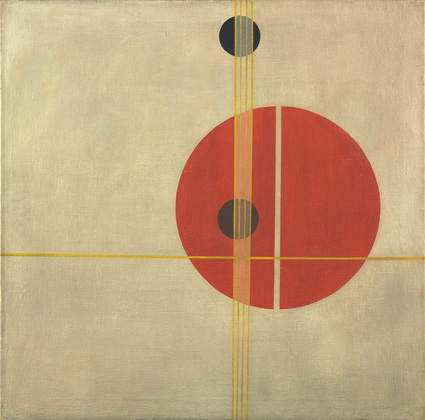
Tschichold “Konstructivisten” poster – Moholy NagyQ 1 Suprematistic painting
read more in the linked pdf “FRESH TASTE OF PEPPERMINT”
Wednesday, May 6, 2009
The work that Jan van Toorn made in 1971 for the van Abbemuseum in Eindhoven is a work that caught my interest from the start. It is very daring of a museum to use a political statement like this as an advertisement for an exhibition.
To me it is graphic design at its best. This work looks in a way very timeless but has a lot to do with the time it was created in. Not only because the valuta of the amount that is added up is in Gulden – which we do not use any more (unfortunately – have a peek at Renske’s posting!) – but more likely because he used paint to tell you which painters you can find at the van Abbemuseum at this exhibition. To me this feels very honest, true and logical. I think Jan van Toorn was ahead of time with this work.
I love how he throws all these big masters on a mathematical pile without actually making fun of it. Of course he is making fun of what all these paintings cost. Almost 40 years later the prices went sky high. But in a way that is not really what it is about, to me it feels like putting it out of context. He makes the master painters more human. To me this poster mocks with the art world without making fun of the painters.
It makes me feel like painting.

Jan van Toorn is a man of the first generation of graphic design. In 50 years he has seen al the revolutions and all the new more advanced options you have with the, let’s say, original or old-fashioned way of printing. Jan van Toorn: ‘The computer is the next phase and is of course an amazing development in the world of graphic design and for a designer to work with, but if I look at the results then I find it very disappointing.’
Van Toorn thinks that the Internet should be or become a medium with visual journalism that frees as well as enriches the reader/viewer. He thinks that a different, new use of language is important for that. I agree with him on this point. If you take blogs for instance, or the Internet in general, you can delete half of it because it is rubbish and has no content. To me it is about balance. People do not read long, dry texts on the Internet. It is about speed. It has to be fast. I think blogs such as ffffound.com are a good example for that. It is an only imagery, no text blog about design. You see a lot of beautiful, esthetic designs, and very often without content. Most of the design you forget instantly. Just nice pictures.
I think that Jan van Toorn despises the Internet because I read that Jan van Toorn is not interested in the beauty or esthetics of images at all. It is mainly and only about the content of the design. What is there to tell, to see or to communicate? As a designer he wants to be more than only the person in between the client and the receiver, he would like to be involved within the whole process.
A nice question I found in an interview with Jan van Toorn on the website of magazine de Groene Amsterdammer (in Dutch) is: Are you designers the mediators that show us reality in life?
Jan van Toorn: Yes.
And we simply have to believe that that is the truth in reality?
Jan van Toorn: Yes. Whether we do it or the church does. 30 Years ago it was the church. Today it is about the people ‘in between’ such as designers, journalists and people who make television.
Graphic design and product design may be present everywhere you go but I think it is art that can show you another truth. I think Jan van Toorn set the standard for graphic design back in the days. All we can do is get inspired.
Wednesday, May 6, 2009
When we went to this exhibition I didn’t have any clue about who Jan Tschichold was, and I was not really having a wow experience there, until I entered the last room and found a huge penguin on the wall, standing in front of me and staring. I must admit that penguins are some of my favourite items. And therefore I choose this one to further investigation.
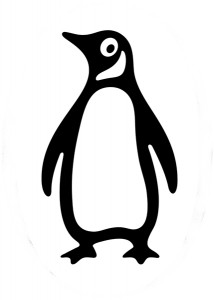
The nice surprise is that this particular penguin is the logo of the penguin books and I wondered how that could be, but Jan Tschichold apparently worked for the Penguin Publisher for two years, and he is the one who made the layout and the “Penguin Composition Rules” a little booklet about the typographic instructions for editors to follow in the future.
It’s fascinating that a publisher so old as the penguin publisher is, still is having this label and still is represented on the market. The story of the penguin books is interesting in many ways, and with this goes a whole history of a publisher.
to be continued with: “A 74 years old penguin“, a further research into Tschichold’s Penguin and others by design.
Wednesday, May 6, 2009
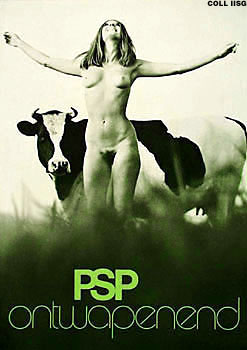
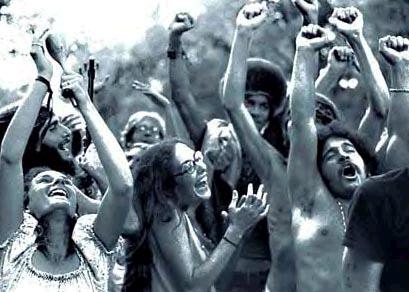
To investigate a design work, i chose the advertisement-poster „PSP ontwapenend“ designed by George Noordanus in 1971.
When i saw the poster, i liked the spirit and the freedom it shows! It has something light and joyful. At the same time it also has something humorous to me. The photograph might stand for the new freedom at that time, won from the 60‘s: the possibility to show nudity in public and even the use of it in advertisement.
Further more, the design and composition of the photograph struck me. The image shows a lot of (formal) parallels: the nudity and vulnerability of the woman and the cow and the pattern of darkness and lightness. Also the setting of the woman and the cow show parallels. And in the end, of course, the context of the slogan „PSP ontwapenend“ in connection with the image is important and interesting to find out more about it!
ANOTHER TIME-SPIRIT
The political background of the poster back then, in the seventies (it raised many controverse reactions), is already discussed so many times. So I decided to relate the poster to recent times: living today, I want to reflect on the poster in the context of today, on the combination of nudity with politics nowadays…. continues as pdf
Wednesday, May 6, 2009
The most intriguing aspect of ‘100 years graphic design in the Netherlands’, out of all the graphics, fonts, posters and publications I saw there, was in my opinion the contrast between two different forms of an Alphabet.
These alphabets, or better Font types, were created by the dutch Graphic Designers Wim Crouwel and Anthon Beeke.
The computerlike and clean structure of Crouwel’s ‘New Alphabet’ and the unconventional and quite controversial looking letter type, made out from naked girls, of Beeke on the other side.
For me Beeke’s style visualizes the spirit of the time when this font was created. It let me think of the sexual revolution, the feministic movement and a general break out of traditional and conventional norms of these times.
But also Crouwel, with his mathmatical looking font, hits for me a certain actuality of the late 60ties and 70ties, as that was the begin of the development of the computer age.
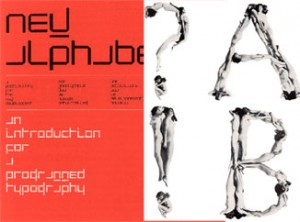
Wim Crouwel vs Anton Beeke
for more on functional versus engagé, read part 2
Wednesday, May 6, 2009

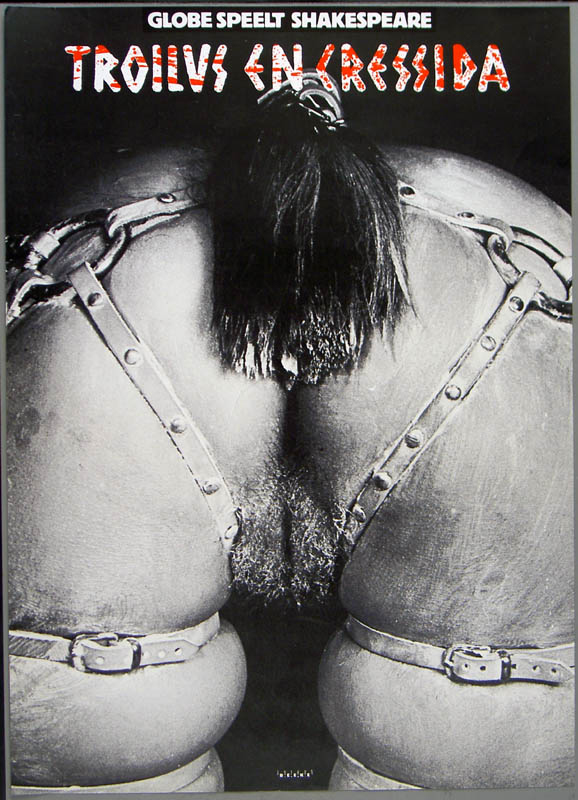
As a student at the Gerrit Rietveld Academy, I went to the Graphic Design Museum in Breda, together with my class. Their collection included pieces from a decade of graphic design. Next to some posters, you could hear interviews with the designer. Sitting down at the table next to the posters, you could see a built-in television with the images of the interview. This was also the case with the poster that took my attention, namely the poster made by Anton Beeke. He made the poster for a relatively obscure play by Shakespeare named “Troilus and Cressida”. The poster intrigued me, because it showed a recognizable human bodypart yet was still somewhat indefinable. This combination added to the mystery of the poster. Using the information table, I found out a lot of backgroundinformation about this seemingly controversial poster. For more posters link to the Affiche museum
When I was sitting at the table in Breda, I was listening to an interview with Anton Beeke. He introduced himself and I discovered that he was a graphic designer with a lot of experience. He made a wide variety of designs for posters, advertisements, books, magazines, stamps and packaging material. The specific subject of the interview were two posters hanging above the information table. Anton Beeke designed them both for the play “Troilus and Cressida”. The picture was very provocative, because it showed the backside of a naked lady who was bending over, only wearing a horse strap. “Troilus and Cressida” is one of the less famous plays by William Shakespeare. It is a sad story about the love between Troilus and Cressida during the Trojan war. Troilus saw that Cressida was behaving all too affectionately with a Greek called Diomedes. That’s when Troilus reckoned she surely was a prostitute. Anton Beeke tells during his interview that being honest is one of the most important principles for him. He saw the play as tragic and sexist and thought he should show just that on his poster. Unfortunately this point wasn’t clear for some. Especially the so called Dolle Mina’s, a feminist movement during the 1960’s, were protesting against the poster.
Links: Trojan War, Anton Beeke[image], Troilus and Cressida[image], Dolle Mina[image]
Wednesday, May 6, 2009
I didn’t know what to expect when we went to the Graphic Design museum in Breda. But when I started at the exhibition about Jan Tschichold I was happily surprised! Actually I liked almost all his work that was shown, the beautiful compositions of form and colour. The work is simple and complex at the same time.
The posters were handmade; you could see the sketches of them and little mistakes or changes in the original version.
I loved that, because it was to me more a painting than a graphic design. You could see the playing of the artist with these forms and colours.
I chose for the poster “Die Frau Ohne Namen” as my favourite one, because it is a beautiful combination of film stills, shapes, line and colour. The triangle of the hat of the woman comes back several times; you see the movement of the train, as it comes out of a tunnel, which gives also the idea of a movie, which is projected. The addition of the colour red makes the image powerful and clear. To me it is a much better film poster than you see today, considering that it is an autonomous artwork.
So shortly said a very strong and beautiful film poster!
Tschichold’s posters interest me the most of his whole oeuvre, so I made a little research about his pictorial posters which you can read in this linked pdf “Jan Tschichold and his pictorial posters“.
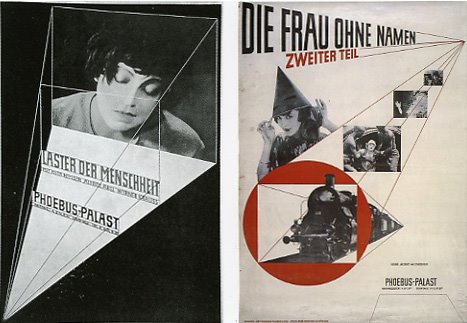
Tuesday, May 5, 2009
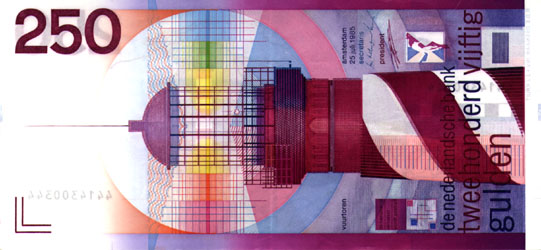
* *
To choose an item in a graphic design museum with which I felt a particular connection wasn’t the easiest thing to do. I am able to see the beauty or the richness of a composed design, but usually it doesn’t grab me like for example a painting can do. In order to do find a reason to be there, except of looking at nice images, I tried to search for a design with which I did feel that personal connection. In the end I choose an item that is as general as it is personal. Our old fashion outdated but beautifully designed Dutch guilder. The paper money that when we look at it nowadays looks more like the monopoly money we used to play with as kids. But it was no children’s game at all. It was the last design in a series of national currency. Maybe it is some sort of melancholy for a time that has past on pure patriotism. In any case I love the design that R.D.E. Oxenaar made. It is the clearness in design, the beautiful intense purple color and the nicely composed graphic elements that intrigues me when I look at it.
But how do we come from a subjective preference to a little history of Dutch banknotes design? This is what I wanted to share with you.
Out of three designers that were asked by the Bank of the Netherlands in 1965 to sketch and design a new series of banknotes, R.D.E. (Ootje) Oxenaar was picked to execute. A tumultuous journey in the world of the printing works was about to start. In the playful way that Oxenaar made his design for the Dutch guilder there seems to be a lot to discover. Did you know that…
* he did put in elements that were accessible for blind people and was the first in the world doing this?
* he hid some personal elements in the banknotes? Like his own fingerprint in the hair of Baruch Spinoza on the 1000 guilder bill and the rabbit of his girlfriend in a watermark.
* Oxenaar underlines the fact that the lighthouse on the 250 guilder bill has something of a phallus symbol, but that he mostly uses it as a symbol of safeness, as something that is watching over the dikes to protect us? A link to the 250 guilder clip on You Tube
THE NEW STANDARD
In a book about the history of Dutch banknotes design I read about the struggles and the slow development stage the design process tended to stay in. Then I read an interesting lecture of Oxenaar
that he gave at a design congress in 1987. read this all in the linked pdf




























